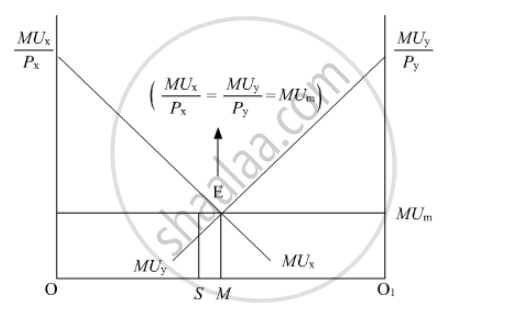Advertisements
Advertisements
Question
“A consumer consumes only two goods X and Y”. State and explain the conditions of consumer’s equilibrium with the help of utility analysis.
Solution
In case of two commodities, the consumer’s equilibrium is attained in accordance with the Law of Equi-Marginal Utility. It states that a consumer allocates his expenditure on two goods in such a manner that the utility derived from each additional unit of the rupee spent on each of the commodities is equal. That is,
Marginal Utility of a Rupee spent on commodity x = Marginal Utility of a Rupee spent on commodity y = Marginal Utility of Money
Or ` (Mu_x)/P_x=(MU_y)/(P_y)=Mu_m`

In the diagram, OO1 represents the total income of a consumer. MUx and MUy represent the Marginal Utility curves of commodity X and commodity Y, respectively. Equilibrium is established at point E, where, MUx and MUy intersect each other and with MUy.
At this point, OM amount of income is spent on commodity X and the remaining amount of income MO1 is spent on commodity Y.
Suppose, instead of point M, the consumer is at point S, where he spends OS amount of income on commodity X and SO1 amount of income on commodity Y. At point S, however;
`(MU_x)/(P_x)>(MU_y)/(P_y)`
Thus, the consumer would increase his consumption of commodity X till the equality is achieved. That is, in other words, the consumer increases his consumption of good X till he reaches point E where,
`(MU_x)/(P_x)=(MU_y)/(P_y)`
APPEARS IN
RELATED QUESTIONS
consumer consumes only two goods X and Y. The Marginal Rate of Substitution is 1. Prices of X and Y are Rs 3 and Rs 4 per unit respectively. Is the consumer in equilibrium? What will be further reaction of the consumer? Give reason.
A consumer consumes only two goods X and Y. The Marginal Rate of Substitution is 2. Prices per unit of X and Y are Rs 5 and Rs 4 respectively. Is consumer in equilibrium? What will be the further reaction of the consumer? Give reasons.
A consumer consumes only two goods X and Y. Marginal rate of substitution is 3 and per unit prices of X and Y is Rs 4 and Rs 2 respectively. Is the consumer in equilibrium? What will be the further reaction of the consumer? Give reasons
Explain the concept of 'Marginal Rate of Substitution' with the help of a numerical example. Also, explain its behaviour along an indifference curve
Define marginal rate of substitution. Explain its behaviour along an indifference curve.
What is the behaviour of Marginal Revenue in a market in which a firm can sell any quantity of the output it produces at a given price?
Answer the following question.
Discuss briefly, using a hypothetical schedule the concept of diminishing marginal rate of substitution.
Answer the following question.
Explain the meaning of the marginal rate of substitution. Why does it diminish as one good is substituted for the other? Explain.
